华兹华斯I wandered lonely as a cloud 赏析
- 格式:ppt
- 大小:1.09 MB
- 文档页数:20
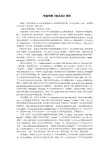
华兹华斯《咏水仙》赏析摘要:华兹华斯是19世纪英国浪漫主义诗歌的代表人物。
本文从格律,语言,意境等方面分析了其代表作《咏水仙》。
关键词:华兹华斯;《咏水仙》;格律华兹华斯(1770--1850)是19世纪英国浪漫主义诗歌的奠基者。
华兹华斯生性敏感孤独,十分热爱自然。
他思想进步,厌恶浮华冷酷的工业社会,积极主张社会变革,希望建立公平,合理,有序的民主社会。
然而法国大革命的失败给他的政治理想以沉重打击。
加之感情生活的受挫,诗人最终决定隐居英国北部的湖畔地区,寄情山水。
静谧的林间,柔美的花朵,秀丽的湖泊——置身纯朴自然之中的华兹华斯终于找到了属于自己的欢乐。
以他为代表的湖畔诗人也开创了英国浪漫主义诗歌的先河。
《咏水仙》就是一首极具华兹华斯自然风格的浪漫主义诗作。
诗人用淳朴自然,简洁易懂的语言描绘了水仙的轻盈柔美,以及其给予人心灵上的愉悦。
从格律上来讲,《咏水仙》属于四段六行诗体(sixtain stanza)。
整首诗韵脚平整:ababcc,efefgg,hihikk,lmlmnn.每段前四行换行押韵,后两行为一个对句,同韵。
每行诗文轻重音相间,基本按照四步抑扬(iambic tetrameter)的韵律进行,读之极具美感。
我们先来看第一节:I wandered lonely as a cloud, \That floats on high o’er vales and hills,(我好像一朵孤独的流云,在山峦峡谷之上高高飘荡)诗人自比孤云,游荡与山谷之间。
“lonely”,“floats”形象地展示出诗人飘然尘上,孤洁无依的内心。
这两行双元音,软元音的杂糅运用显示出一种柔和,悠远的意境。
轻重相间的音节抑扬顿挫,宛然浮云的缓缓飘动。
而后两行场景蓦地一转:When I saw a crowd, \A host, of golden daffodils;(忽然我看到一大片金黄的水仙花迎风开放) “all at once”三个单音节的词使前两行的悠远意境一转,突出了诗人初见水仙时的惊喜欢愉。
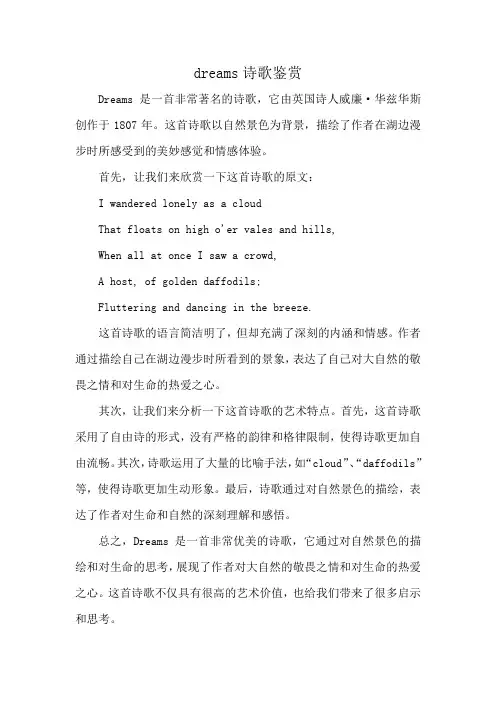
dreams诗歌鉴赏
Dreams是一首非常著名的诗歌,它由英国诗人威廉·华兹华斯创作于1807年。
这首诗歌以自然景色为背景,描绘了作者在湖边漫步时所感受到的美妙感觉和情感体验。
首先,让我们来欣赏一下这首诗歌的原文:
I wandered lonely as a cloud
That floats on high o'er vales and hills,
When all at once I saw a crowd,
A host, of golden daffodils;
Fluttering and dancing in the breeze.
这首诗歌的语言简洁明了,但却充满了深刻的内涵和情感。
作者通过描绘自己在湖边漫步时所看到的景象,表达了自己对大自然的敬畏之情和对生命的热爱之心。
其次,让我们来分析一下这首诗歌的艺术特点。
首先,这首诗歌采用了自由诗的形式,没有严格的韵律和格律限制,使得诗歌更加自由流畅。
其次,诗歌运用了大量的比喻手法,如“cloud”、“daffodils”等,使得诗歌更加生动形象。
最后,诗歌通过对自然景色的描绘,表达了作者对生命和自然的深刻理解和感悟。
总之,Dreams是一首非常优美的诗歌,它通过对自然景色的描绘和对生命的思考,展现了作者对大自然的敬畏之情和对生命的热爱之心。
这首诗歌不仅具有很高的艺术价值,也给我们带来了很多启示和思考。

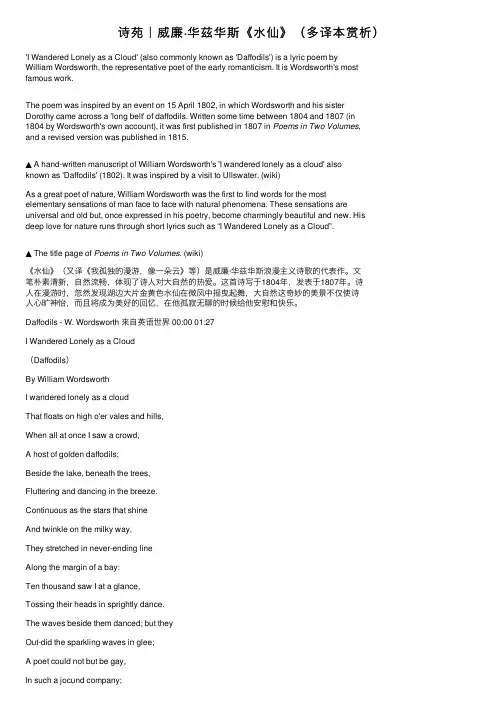
诗苑|威廉·华兹华斯《⽔仙》(多译本赏析)'I Wandered Lonely as a Cloud' (also commonly known as 'Daffodils') is a lyric poem byWilliam Wordsworth, the representative poet of the early romanticism. It is Wordsworth's most famous work.The poem was inspired by an event on 15 April 1802, in which Wordsworth and his sister Dorothy came across a 'long belt' of daffodils. Written some time between 1804 and 1807 (in1804 by Wordsworth's own account), it was first published in 1807 in Poems in Two Volumes,and a revised version was published in 1815.▲ A hand-written manuscript of William Wordsworth's 'I wandered lonely as a cloud' alsoknown as 'Daffodils' (1802). It was inspired by a visit to Ullswater. (wiki)As a great poet of nature, William Wordsworth was the first to find words for the mostelementary sensations of man face to face with natural phenomena. These sensations are universal and old but, once expressed in his poetry, become charmingly beautiful and new. His deep love for nature runs through short lyrics such as “I Wandered Lonely as a Cloud”.▲ The title page of Poems in Two Volumes. (wiki)《⽔仙》(⼜译《我孤独的漫游,像⼀朵云》等)是威廉·华兹华斯浪漫主义诗歌的代表作。
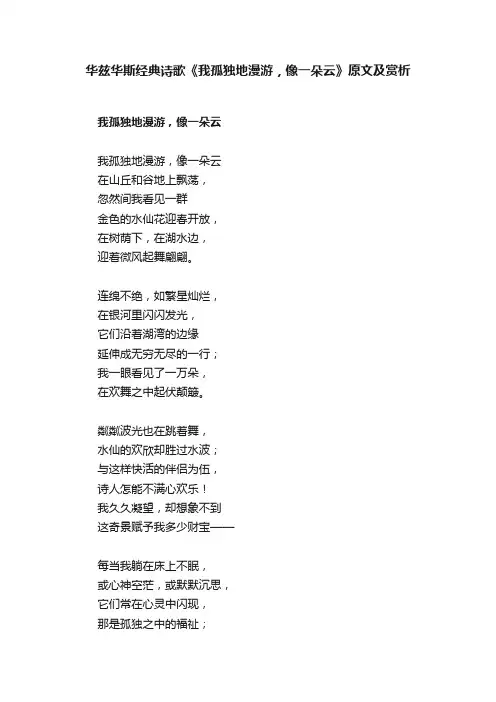
华兹华斯经典诗歌《我孤独地漫游,像一朵云》原文及赏析我孤独地漫游,像一朵云我孤独地漫游,像一朵云在山丘和谷地上飘荡,忽然间我看见一群金色的水仙花迎春开放,在树荫下,在湖水边,迎着微风起舞翩翩。
连绵不绝,如繁星灿烂,在银河里闪闪发光,它们沿着湖湾的边缘延伸成无穷无尽的一行;我一眼看见了一万朵,在欢舞之中起伏颠簸。
粼粼波光也在跳着舞,水仙的欢欣却胜过水波;与这样快活的伴侣为伍,诗人怎能不满心欢乐!我久久凝望,却想象不到这奇景赋予我多少财宝——每当我躺在床上不眠,或心神空茫,或默默沉思,它们常在心灵中闪现,那是孤独之中的福祉;于是我的心便涨满幸福,和水仙一同翩翩起舞。
(飞白译)李好摘要:《我孤独地漫游,像一朵云》是英国浪漫主义诗人华兹华斯的代表作之一,因其文笔清新,自然流畅而广为流传。
本文主要从诗歌的韵律,语篇衔接和思想内容三个方面鉴赏此诗。
威廉·华兹华斯(1770-1850)是“湖畔诗人”的领袖,同时也是19世纪英国浪漫主义诗人的杰出代表。
早年他受到法国启蒙主义思想,尤其是卢梭“回归自然”的影响。
英法战争爆发后,他“归隐”湖畔,致力于诗歌创作,并逐渐构建了自己的诗歌创作理论。
《我孤独地漫游,像一朵云》则是他其中的代表作之一,为英国浪漫主义诗歌的创作定下了基调。
[1]华兹华斯与柯勒律治、骚同被称为“湖畔派”诗人。
他们也是英国文学中最早出现的浪漫主义作家。
他们喜爱大自然,描写宗法制农村生活,厌恶资本主义的城市文明和冷酷的金钱关系,他们远离城市,隐居在昆布兰湖区和格拉斯米尔湖区,由此得名“湖畔派”。
华兹华斯认为“所有的好诗都是强烈情感的自然流露”,主张诗人“选用人们真正用的语言”来写“普通生活里的事件和情境”,而反对以18世纪格雷为代表的“诗歌词藻”。
他进而论述诗和诗人的崇高地位,认为诗非等闲之物,“诗是一切知识的开始和终结,它同人心一样不朽”,而诗人则是“人性的最坚强的保护者,支持者和维护者。

《I wandered lonely as a cloud》两篇译文对比鉴赏关于作者华兹华斯及其贡献华兹华斯,英国诗人,生于律师之家。
1783年他的父亲去世,他和弟兄们由舅父照管,妹妹多萝西则由外祖父母抚养。
多萝西与他最为亲近,终身未嫁,一直与他作伴。
1787年他进剑桥大学圣约翰学院学习,大学毕业后去法国。
他对法国革命怀有热情,认为这场革命表现了人性的完美,将拯救帝制之下处于水深火热中的人民。
1792年华兹华斯回到伦敦,仍对革命充满热情。
但他的舅父对他的政治活动表示不满,不愿再予接济。
于是在1795年10月,他与多萝西一起迁居乡间,实现接近自然并探讨人生意义的宿愿。
William Wordsworth(1770-1850)华兹华斯与Samuel Taylor、Robert Southey同被称为“湖畔派”诗人。
他们是英国文学中最早出现的浪漫主义作家。
他们喜爱大自然,描写宗法制农村生活,厌恶资本主义的城市文明和冷酷的金钱关系,他们远离城市,隐居在昆布兰湖区和格拉斯米尔湖区,由此得名“湖畔派”。
“湖畔派”三诗人中成就最高者为华兹华斯。
他于1789年和柯勒律治合作发表了《抒情歌谣集》,宣告了浪漫主义新诗的诞生。
两年后再版,华兹华斯加了一个长序,在这篇序中,他详细阐述了他的浪漫主义文学主张,主张以平民的语言抒写平民的事物、思想与感情,被誉为浪漫主义诗歌的宣言,动摇了英国古典主义诗学的统治,有力地推动了英国诗歌的革新和浪漫主义运动的发展。
然而纵观他的一生,其诗歌成就是突出的,不愧为继莎士比亚、弥尔顿之后的一代大家。
关于《I wandered lonely as a cloud》这首诗写于诗人从法国回来不久。
诗人带着对自由的向往去了法国,参加一些革命活动。
但法国革命没有带来预期的结果,随之而来的是混乱。
诗人的失望和受的打击是可想而知的,后来在他的朋友和妹妹的帮助下,情绪才得以艰难地恢复。
这首诗就写于诗人的心情平静之后不久。
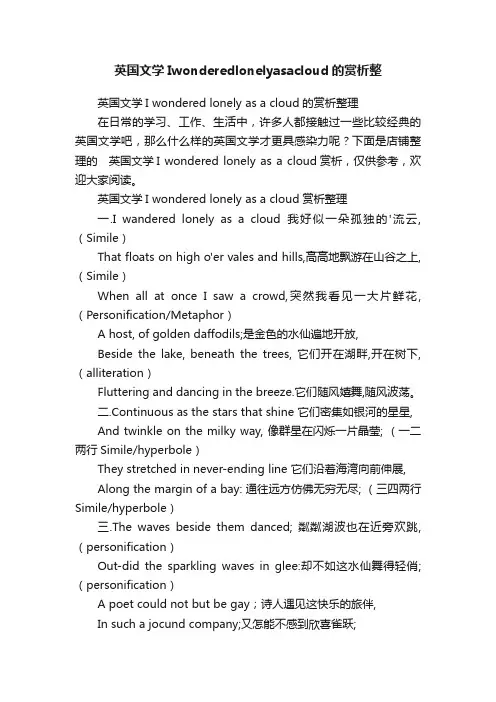
英国文学Iwonderedlonelyasacloud的赏析整英国文学I wondered lonely as a cloud的赏析整理在日常的学习、工作、生活中,许多人都接触过一些比较经典的英国文学吧,那么什么样的英国文学才更具感染力呢?下面是店铺整理的英国文学I wondered lonely as a cloud赏析,仅供参考,欢迎大家阅读。
英国文学I wondered lonely as a cloud赏析整理一.I wandered lonely as a cloud我好似一朵孤独的'流云,(Simile)That floats on high o'er vales and hills,高高地飘游在山谷之上, (Simile)When all at once I saw a crowd,突然我看见一大片鲜花, (Personification/Metaphor)A host, of golden daffodils;是金色的水仙遍地开放,Beside the lake, beneath the trees, 它们开在湖畔,开在树下,(alliteration)Fluttering and dancing in the breeze.它们随风嬉舞,随风波荡。
二.Continuous as the stars that shine 它们密集如银河的星星,And twinkle on the milky way, 像群星在闪烁一片晶莹; (一二两行Simile/hyperbole)They stretched in never-ending line 它们沿着海湾向前伸展,Along the margin of a bay: 通往远方仿佛无穷无尽; (三四两行Simile/hyperbole)三.The waves beside them danced; 粼粼湖波也在近旁欢跳, (personification)Out-did the sparkling waves in glee:却不如这水仙舞得轻俏; (personification)A poet could not but be gay;诗人遇见这快乐的旅伴,In such a jocund company;又怎能不感到欣喜雀跃;I gazed—and gazed—but little thought.我久久凝视——却未领悟What wealth the show to me had brought:...这景象所给我的精神之宝。
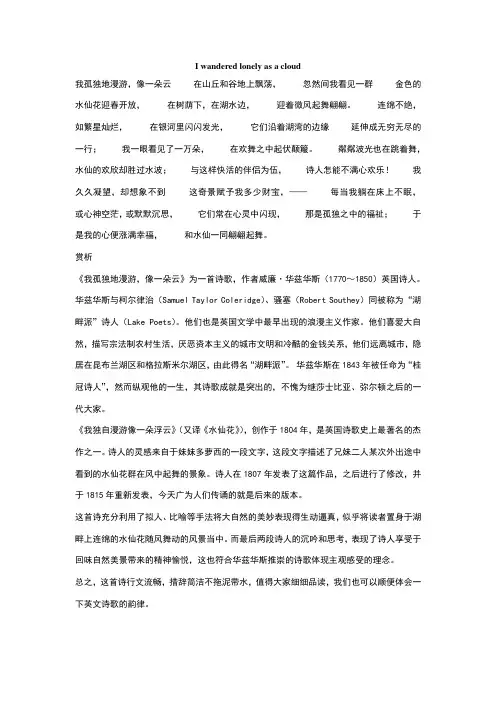
I wandered lonely as a cloud我孤独地漫游,像一朵云在山丘和谷地上飘荡,忽然间我看见一群金色的水仙花迎春开放,在树荫下,在湖水边,迎着微风起舞翩翩。
连绵不绝,如繁星灿烂,在银河里闪闪发光,它们沿着湖湾的边缘延伸成无穷无尽的一行;我一眼看见了一万朵,在欢舞之中起伏颠簸。
粼粼波光也在跳着舞,水仙的欢欣却胜过水波;与这样快活的伴侣为伍,诗人怎能不满心欢乐!我久久凝望,却想象不到这奇景赋予我多少财宝,——每当我躺在床上不眠,或心神空茫,或默默沉思,它们常在心灵中闪现,那是孤独之中的福祉;于是我的心便涨满幸福,和水仙一同翩翩起舞。
赏析《我孤独地漫游,像一朵云》为一首诗歌,作者威廉·华兹华斯(1770~1850)英国诗人。
华兹华斯与柯尔律治(Samuel Taylor Coleridge)、骚塞(Robert Southey)同被称为“湖畔派”诗人(Lake Poets)。
他们也是英国文学中最早出现的浪漫主义作家。
他们喜爱大自然,描写宗法制农村生活,厌恶资本主义的城市文明和冷酷的金钱关系,他们远离城市,隐居在昆布兰湖区和格拉斯米尔湖区,由此得名“湖畔派”。
华兹华斯在1843年被任命为“桂冠诗人”,然而纵观他的一生,其诗歌成就是突出的,不愧为继莎士比亚、弥尔顿之后的一代大家。
《我独自漫游像一朵浮云》(又译《水仙花》),创作于1804年,是英国诗歌史上最著名的杰作之一。
诗人的灵感来自于妹妹多萝西的一段文字,这段文字描述了兄妹二人某次外出途中看到的水仙花群在风中起舞的景象。
诗人在1807年发表了这篇作品,之后进行了修改,并于1815年重新发表,今天广为人们传诵的就是后来的版本。
这首诗充分利用了拟人、比喻等手法将大自然的美妙表现得生动逼真,似乎将读者置身于湖畔上连绵的水仙花随风舞动的风景当中。
而最后两段诗人的沉吟和思考,表现了诗人享受于回味自然美景带来的精神愉悦,这也符合华兹华斯推崇的诗歌体现主观感受的理念。

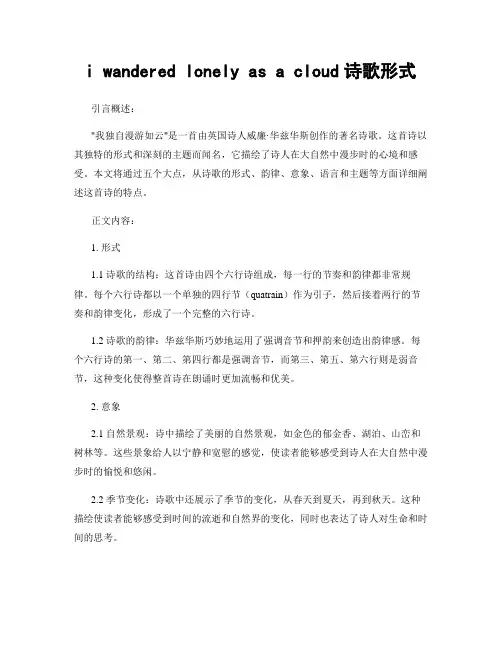
i wandered lonely as a cloud诗歌形式引言概述:"我独自漫游如云"是一首由英国诗人威廉·华兹华斯创作的著名诗歌。
这首诗以其独特的形式和深刻的主题而闻名,它描绘了诗人在大自然中漫步时的心境和感受。
本文将通过五个大点,从诗歌的形式、韵律、意象、语言和主题等方面详细阐述这首诗的特点。
正文内容:1. 形式1.1 诗歌的结构:这首诗由四个六行诗组成,每一行的节奏和韵律都非常规律。
每个六行诗都以一个单独的四行节(quatrain)作为引子,然后接着两行的节奏和韵律变化,形成了一个完整的六行诗。
1.2 诗歌的韵律:华兹华斯巧妙地运用了强调音节和押韵来创造出韵律感。
每个六行诗的第一、第二、第四行都是强调音节,而第三、第五、第六行则是弱音节,这种变化使得整首诗在朗诵时更加流畅和优美。
2. 意象2.1 自然景观:诗中描绘了美丽的自然景观,如金色的郁金香、湖泊、山峦和树林等。
这些景象给人以宁静和宽慰的感觉,使读者能够感受到诗人在大自然中漫步时的愉悦和悠闲。
2.2 季节变化:诗歌中还展示了季节的变化,从春天到夏天,再到秋天。
这种描绘使读者能够感受到时间的流逝和自然界的变化,同时也表达了诗人对生命和时间的思考。
2.3 内心世界:诗中诗人的内心世界也得到了揭示。
诗人通过描绘自然景观来表达自己的情感和思想,他的内心世界与自然景观相互交织,使诗歌更加丰富和深刻。
3. 语言3.1 诗歌的抒情性:诗歌中使用了丰富的修辞手法,如比喻、拟人等,增强了诗歌的抒情性。
诗人通过这些修辞手法将自己的情感和思想融入到诗歌中,使读者能够更好地感受到诗人的情感和思想。
3.2 诗歌的简洁性:华兹华斯在诗歌中使用了简洁明了的语言,使诗歌更加易于理解和回味。
他用简洁的语言表达了复杂的情感和思想,使诗歌更加深入人心。
4. 主题4.1 自然与人类的关系:诗歌表达了自然与人类之间的关系。
诗人通过描绘自然景观和自己的情感,表达了人类与自然相互依存和相互影响的关系。

I Wandered Lonely as a Cloudemploys masculine rhy me(A shift of his feelings)I wandered lonely as a cloudThat floats on high o'er vales and hills,When all at once I saw a crowd,A host,of golden daffodils;Beside the lake,beneath the trees,Fluttering and dancing in the breeze。
Continuous as the stars that shineAnd twinkle on the Milky Way,They stretched in never-ending lineAlong the margin of a bay:Ten thousand saw I at a glance,Tossing their heads in sprightly dance。
The waves beside them danced; but they Out-did the sparkling waves in glee:A poet could not but be gay,In such a jocund company:I gazed——-and gazed---but little thought What wealth the show to me had brought:For oft,when on my couch I lieIn vacant or in pensive mood,They flash upon that inward eyeWhich is the bliss of solitude;And then my heart with pleasure fills,And dances with the daffodils。
I Wandered Lonely as a Cloudemploys masculine rhy me(A shift of his feelings)I wandered lonely as a cloudThat floats on high o'er vales and hills,When all at once I saw a crowd,A host, of golden daffodils;Beside the lake, beneath the trees,Fluttering and dancing in the breeze.Continuous as the stars that shineAnd twinkle on the Milky Way,They stretched in never-ending lineAlong the margin of a bay:Ten thousand saw I at a glance, Tossing their heads in sprightly dance.The waves beside them danced; but they Out-did the sparkling waves in glee:A poet could not but be gay,In such a jocund company:I gazed---and gazed---but little thought What wealth the show to me had brought:For oft, when on my couch I lieIn vacant or in pensive mood,They flash upon that inward eyeWhich is the bliss of solitude;And then my heart with pleasure fills,And dances with the daffodils.Comment: I Wandered Lonely as a Cloud“I Wandered Lonely as a Cloud” was written by William Wor dsworth, the representative poet of the early romanticism. As a great poet of nature, William Wordsworth was the first to fin d words for the most elementary sensations of man face to fa ce with natural phenomena. These sensations are universal and old but, once expressed in his poetry, become charmingly beau tiful and new. His deep love for nature runs through short lyri cs such as “I Wandered Lonely as a Cloud” The poem implies that the relation between the poem and nature is one of unity and that they can be one. The poem has become nature itself in the poem.“I Wandered Lonely as a Cloud” is a poem about nature. With h is pure and poetic language, Wordsworth brings us into a beautiful world where there are daffodils, trees and breeze. We follow the p oet at every turn of his feelings. We share his melancholy when he “wandered lonely as a cloud” and his delight the moment his heart “with pleasure fills ”. We come to realize the great power of nature that may influence our life deeply as revealed in the poem. In the poem “I Wandered Lonely as a Cloud”, the poet also make s great use of the “music ”of the language to achieve sound beauty in addition to convey meaning. He employs masculine rhyme in “a, b, a, b, c, c” pattern to receive emphasis as a musical effect. (e.g. “cloud” (a), “hills” (b), “crowd” (a), “daffodils” (b), “trees” (c), “br eeze” (c) in stanza 1). He also achieves musical quality by the ma nagement of alliteration (e.g. “That floats on high o’er vales and hills” in line 2 and “Beside the lake, beneath the trees” in line 5) and assonance (e.g. “beneath the trees in line 5” and “ They stretc hed in never-ending line” in line 9) and consonance (e.g. “ vales a nd hills” in line 2 ). Besides the repetition of sounds, the poet also makes his poem a strong appeal for us in language that is rhythmi cal. He arranges his poem in lines of iambic tetrameter(四步抑扬) i n the main with alternation(交替)of iambic tetrameter.( e.g. I wandered lonely as a cloudThat floats on high o’er vales and hillsWhen all at once I saw a crowdA host, of golden daffodilsBeside the lake, beneath the treesFluttering and dancing in the breeze )He slowed down the tempo in line 4 to keep in accordance with his bated breath the moment he glimpses at a host of golden daffo dils thus convey to us the poet’s intoxication in the face of nature. With all these musical devices, Wordsworth secures a songlike effe ct of his poem in addition to communicate his emotion and meanin g.An old saying goes “There are pictures in poetry and poetry in pi ctures”. It finds its most eloquent examples in most of the Chinese Tang poems that present the readers with beautiful pictures. In the poem “I Wandered Lonely as a Cloud”, the poet also seeks to expr ess his emotions by providing the sense impressions he has through imagery. He depicts(描绘)a picture in which “a host of golden daffodils (visual imagery) fluttering and dancing in the breeze” so v ividly that it appeals richly(气味浓郁芬芳地)to our senses and t o our imagination.Wordsworth, in the poem, also employs figurative(比喻的)lang uage to evoke not only the visual effect but also the emotional res ponse. (e.g. in line 1, the poet makes a comparison between “I wa ndered lonely” and “a cloud” by the use of simile, thus convey tous his lonely and melancholy(令人悲哀的,令人沮丧的)mood with the image of “cloud”. In line 7, he also amplifies the visual e ffect by the use of another simile “Continuous as the stars that shi ne…” to evoke our sense of “daffodils” with the image of “stars” t winkling on the milky way which is familiar to us all. He goes fur ther to impress us with the image of countless daffodils with an ov erstatement in line 9 “They stretched in never-ending line”). Beside s, natural things are also endowed with human being’s characters b y the poet’s subtle use of personification. (e.g. “Tossing their heads in sprightly dance” “The waves beside them danced”) therefore, as we read the poem, we become aware of the poet’s deep love towar d nature through his lovely and vivid description about natural thin gs with his figurative language.What’s more, Wordsworth goes further to communicate his emotion and meaning by his thoughtful tone. The choose of the word “lonel y” in “I wandered lonely as a cloud” instead of other words like c arefree(无忧无虑的), leisure or jolly convey to us the poet’s dep ression and disconsolateness(忧郁,沮丧)at the very beginning. But as he catches sight of daffodils stretching as far as the eyes ca n see and finds himself in the midst of nature, his loneliness turns into relaxation and joy. Thus the shift of the poet’s mood from sad我好似一朵孤独的流云,高高地飘游在山谷之上,突然我看见一大片鲜花,是金色的水仙遍地开放,它们开在湖畔,开在树下,它们随风嬉舞,随风波荡。
英诗《咏水仙》艺术特色解读---《名作欣赏·下旬刊》2009年第8期发布: 2010-1-08 10:54 | 作者: 出水莲| 来源: 云梦中文网关键词: 华兹华斯水仙花艺术特色摘要:《咏水仙》是英国诗人威廉·华兹华斯的一首抒情诗。
诗中他以水仙花为主线,描写了大自然的优美风光。
诗人同时借景抒情,流露出了他的悲观情绪。
本文从音韵、视觉、意境三方面来解读诗的艺术特色。
我好似一朵孤独的流云,高高地飘游在山谷之上,突然我看见一大片鲜花,是金色的水仙遍地开放,它们开在湖畔,开在树下,它们随风嬉舞,随风波荡。
它们密集如银河的星星,像群星在闪烁一片晶莹;它们沿着海湾向前伸展,通往远方仿佛无穷无尽;一眼看去就有千朵万朵,万花摇首舞得多么高兴。
粼粼湖波也在近旁欢跳,却不如这水仙舞得轻俏;诗人遇见这快乐的旅伴,又怎能不感到欣喜雀跃;我久久凝视——却未领悟这景象所给我的精神之宝。
后来多少次我郁郁独卧,感到百无聊赖心灵空漠;这景象便在脑海中闪现,多少次安慰过我的寂寞;我的心又随水仙跳起舞来,我的心又重新充满了欢乐。
——[英]威廉·华兹华斯:《咏水仙》①《咏水仙》是英国消极浪漫主义诗人威廉·华兹华斯的代表作之一。
由于华兹华斯在英国西北部的湖畔地区度过了一生中的大半时光,所以又被称作“湖畔派诗人”。
以他为代表的“湖畔派诗人”被认为是英国的第一代浪漫主义诗人。
1843年他被封为桂冠诗人。
同其他“湖畔派诗人”一样,华兹华斯早年同情并歌颂法国革命,后趋向保守,甚至赞扬农村的封建宗法制度,同以拜伦、雪莱为代表的积极浪漫主义形成了鲜明的对比。
华兹华斯认为一切好诗都是强烈情感的自然流露,而思想则改变和指导着情感的流注。
他提倡诗歌的题材应从宫廷转向民间,从城市转向山乡湖畔,主张“选择日常生活的事件和情节”。
因为普通人的生活要比王公贵族的生活含有更多的诗意,田园生活要比宫廷生活、城市生活更富有自然美。
[精品]英国文学I wondered lonely as a cloud赏析整理
英国诗歌“我孤单彷徨,如云那般”是由英国诗人威廉·华兹华斯(William Wordsworth)所作,现存于他的诗集《二十六首诗歌》第九首,也被称为“独行云”
(The Solitary Cloud)。
这首诗歌也是英国浪漫主义文学的一首杰作,也是最适合代表
英国浪漫主义运动的哑剧精品之一。
这首诗歌以威廉·华兹华斯解释世界为起始,怀着对友谊,亲情与爱情的雅正之心,
抒发自然自由的力量。
其旋律轻快,像是一位年轻人,在做一些宁静平和的事情时,表达
出他无畏无伤的心情。
歌词中的颜色,像极了晴天的天空,这些天空幻想的形象,演绎出
自然,微静而冷艳的凉意,调和出华兹华斯那对温柔和谐,田园化的绿色的看法。
此首诗歌的灵魂是抒情的,他用自然朴实的话语,表达出浪漫时期的狂热。
它宣告着
英国浪漫主义运动的开始,标志着英语诗歌不再是一种传统形式,而是一种抒情文学,这
点华兹华斯在这首诗中要让人感受到很深。
这首诗歌深沉而富有寓意,威廉·华兹华斯在那边浅薄而少知的少年心情中,表达了
他对人际关系、生活与未来的强烈期望。
在他看来,有和一样乐观美好的未来可以去争取。
他用朴实的抒情去描绘着自己的心态,这使得这首诗更加具有激情,更加写实,言简意赅,令人心怀良知,令人心情欣然。
威廉·华兹华斯的这首诗话不多,但却能够收获千家万着,他的这首精妙的小诗不但
描绘出了自然的美丽,也滋养了人们的诗意思想,意作一片生活中最美好的舞台,使人产
生更多的美好愿景与向往。
I wandered lonely as a cloud我孤独地漫游,像一朵云在山丘和谷地上飘荡,忽然间我看见一群金色的水仙花迎春开放,在树荫下,在湖水边,迎着微风起舞翩翩。
连绵不绝,如繁星灿烂,在银河里闪闪发光,它们沿着湖湾的边缘延伸成无穷无尽的一行;我一眼看见了一万朵,在欢舞之中起伏颠簸。
粼粼波光也在跳着舞,水仙的欢欣却胜过水波;与这样快活的伴侣为伍,诗人怎能不满心欢乐!我久久凝望,却想象不到这奇景赋予我多少财宝,——每当我躺在床上不眠,或心神空茫,或默默沉思,它们常在心灵中闪现,那是孤独之中的福祉;于是我的心便涨满幸福,和水仙一同翩翩起舞。
赏析《我孤独地漫游,像一朵云》为一首诗歌,作者威廉·华兹华斯(1770~1850)英国诗人。
华兹华斯与柯尔律治(Samuel Taylor Coleridge)、骚塞(Robert Southey)同被称为“湖畔派”诗人(Lake Poets)。
他们也是英国文学中最早出现的浪漫主义作家。
他们喜爱大自然,描写宗法制农村生活,厌恶资本主义的城市文明和冷酷的金钱关系,他们远离城市,隐居在昆布兰湖区和格拉斯米尔湖区,由此得名“湖畔派”。
华兹华斯在1843年被任命为“桂冠诗人”,然而纵观他的一生,其诗歌成就是突出的,不愧为继莎士比亚、弥尔顿之后的一代大家。
《我独自漫游像一朵浮云》(又译《水仙花》),创作于1804年,是英国诗歌史上最著名的杰作之一。
诗人的灵感来自于妹妹多萝西的一段文字,这段文字描述了兄妹二人某次外出途中看到的水仙花群在风中起舞的景象。
诗人在1807年发表了这篇作品,之后进行了修改,并于1815年重新发表,今天广为人们传诵的就是后来的版本。
这首诗充分利用了拟人、比喻等手法将大自然的美妙表现得生动逼真,似乎将读者置身于湖畔上连绵的水仙花随风舞动的风景当中。
而最后两段诗人的沉吟和思考,表现了诗人享受于回味自然美景带来的精神愉悦,这也符合华兹华斯推崇的诗歌体现主观感受的理念。